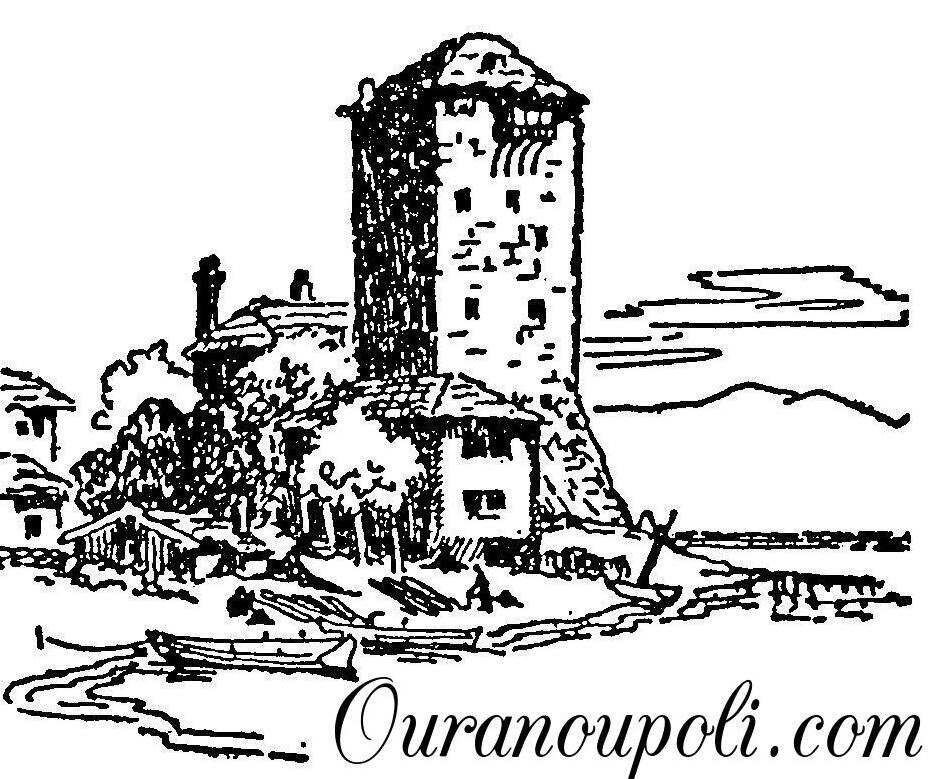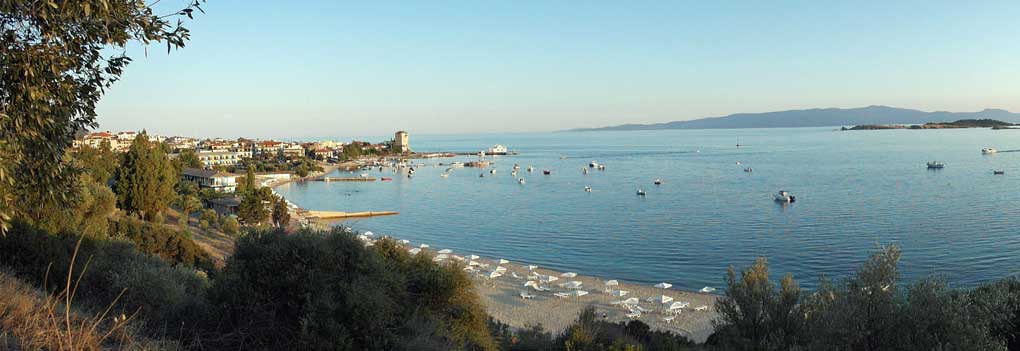
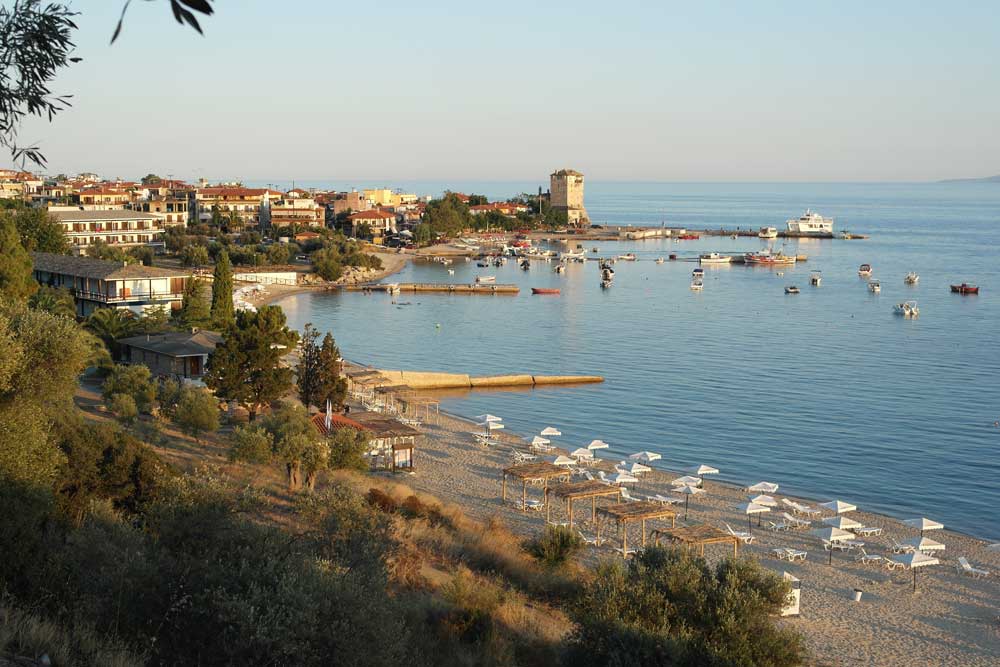
The long, winding road comes to an abrupt end 145 kilometres from Thessaloniki and the airport, at the foot of an old tower. This is the end of the road, the border to the unique monastic state of Mount Athos, the Holy Mountain. This is the picturesque village of Ouranoupolis. Approximately a hundred houses huddling around a Byzantine tower, on the north finger of the Halkidiki peninsula in Northern Greece. The gateway to Mount Athos, the port of passage for pilgrims and scholars alike who visit this unique monastic republic. The small village blessed with a mild climate (Click here to see today’s weather), a clear blue sea and endless golden beaches.
The most memorable view of Ouranoupolis is from the top of the hill just after the town of Ierissos, at the point where the road crosses over from the north to the south side of the Athos peninsula. Pass the tiny whitewashed chapel of St Paul to the left, then a couple of sharp bends and the bay of Agio Oros unfolds in front of your eyes. To the left lies the village of Nea Roda, the place where Xerxes, the Persian King, cut a canal across the peninsula for his ships to pass. To the right by the shore lies the hamlet of Tripity, and further across the limpid sea the long island of Ammouliani, like a dark green lizard sunning itself. At the foot of Ammuliani are the Drenia Islands, a group of uninhabited islets, some no more than tiny rocky outcrops, charcoals scattered by some giant hand in ancient times. Follow the yellow line of sandy coastline straight ahead, and far in the distance a tower rises from the unruffled blue sea, white houses sprawling away from it, bathing in the early morning sunlight. And even further in the horizon, like a giant background, the grey snow capped summit of Mount Athos appears in the early morning mist.
Because of it’s relative isolation Ouranoupolis has not been effected by mass tourism. It was part of Mount Athos until 1922, when approximately 50 families, Greek refugees from Asia Minor arrived under the auspices of the League of Nations, looking for a new home. The land was provided by Mount Athos and each family was given an one bedroom house, an arid plot of land and ten sheep. More families arrived four years later.
Without a road to connect it to the rest of the world the village remained isolated and life was hard. In 1947 the locals took shovels and spades and cut a crude dirt-track road which ended the isolation and brought the very first adventurous tourists to the
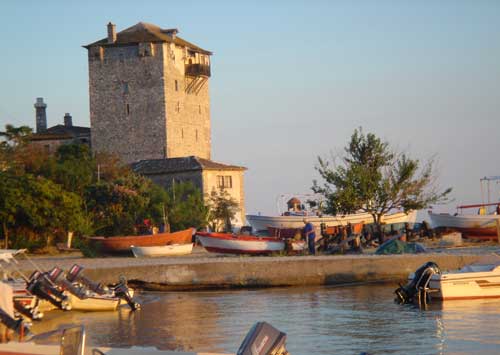
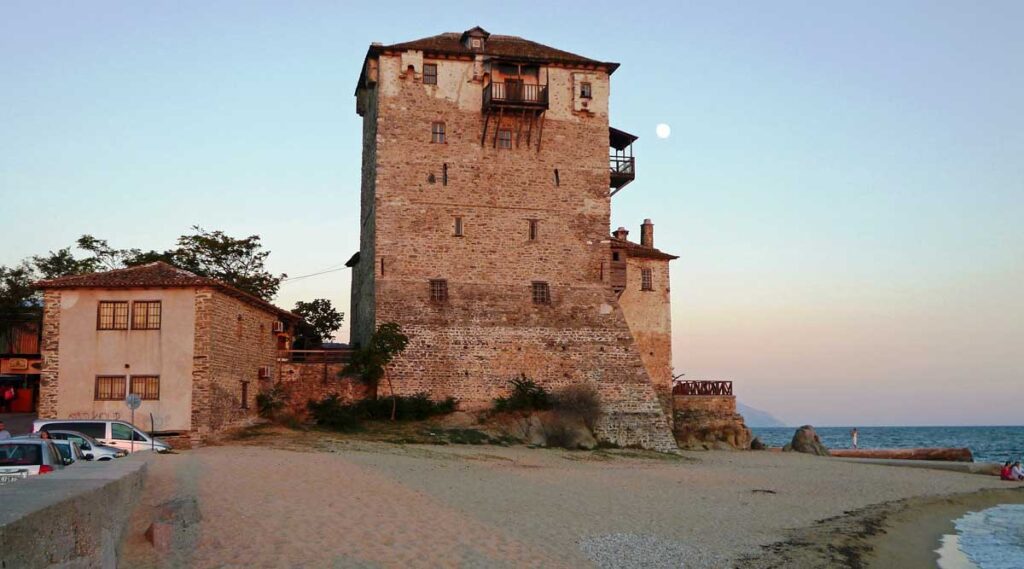
The imposing landmark of Ouranoupolis is the fortified Byzantine tower which nests on the rocks on the sea-front by the jetty. Mystic, gleaming blue-white in the full moonlight, or pink-stained in the setting sun. A sentry on the border to the Holy Mountain. It is the largest monumental structure in Halkidiki and was built in the 14th century by the monastery of Vatopedi, for the protection of it’s metochion (farm) in the area. Tradition has it that it was built by the Byzantine emperor Andronicos II (1282-1328) who financed many projects in Mount Athos.
The tower is a tall stone structure with narrow windows and slits only on the upper floors, a testimony to past pirate raids and battles. It is entered through a courtyard and a large wooden doorway, which is reinforced with metal studs. A steep creaking staircase leads to the upper floors where two wooden balconies cling precariously to the outside walls. A small chapel is there, and a two headed
Byzantine eagle engraved on the stone floor testifies to the age of the building. The chapel was used by the locals for many years until the present church was built. In a recess on one of the balconies an old human scull surveys the sea below. It is thought to be the scull of an Abbot who was killed by pirates. The tower has now been restored and serves as a museum of Christian antiquities from Halkidiki.
The residents of the tower for many years were Joice and Sydney Loch. Her an Australian, him a Scott, they came to the area soon after the first locals arrived. They were writers who were sent by the Quaker organisation to help refugees all over the world and particularly in Poland. Their intention was to spend a relaxing summer on one of the deserted islands opposite Ouranoupolis. However, when they saw the mysterious tower and the little village around it they fell under it’s spell, moved into the tower and lived there until their death, approximately ten years ago. They helped the young community establish itself, providing much needed nursing care and medicines. They also encouraged the production of hand made carpets, a craft that was brought by the locals from Asia Minor and developed it into a very successful cottage industry.
The beauty of Ouranoupolis is in it’s long sandy beaches, the clear blue sea, the lonesome coves and the deserted islets waiting to be discovered. The village is sea-kissed from two sides with a long street following the coastline, a favourite place for the evening stroll. The houses, none higher that two storeys, white-washed, with red tile roofs and wooden balconies. The cobbled narrow streets are lined with an abundance of flowers, geraniums and carnations planted in pots. Flowery Boucavilias of all colours, bright red, mauve, white, cascade over the balconies and fences, a feast to the eyes.
The small village church with it’s own bell tower and wooden narthex occupies the central position in the village. This is the meeting place for every christening, every wedding and every funeral. The clear church bell reverberates throughout the village every evening and three times on Sundays.
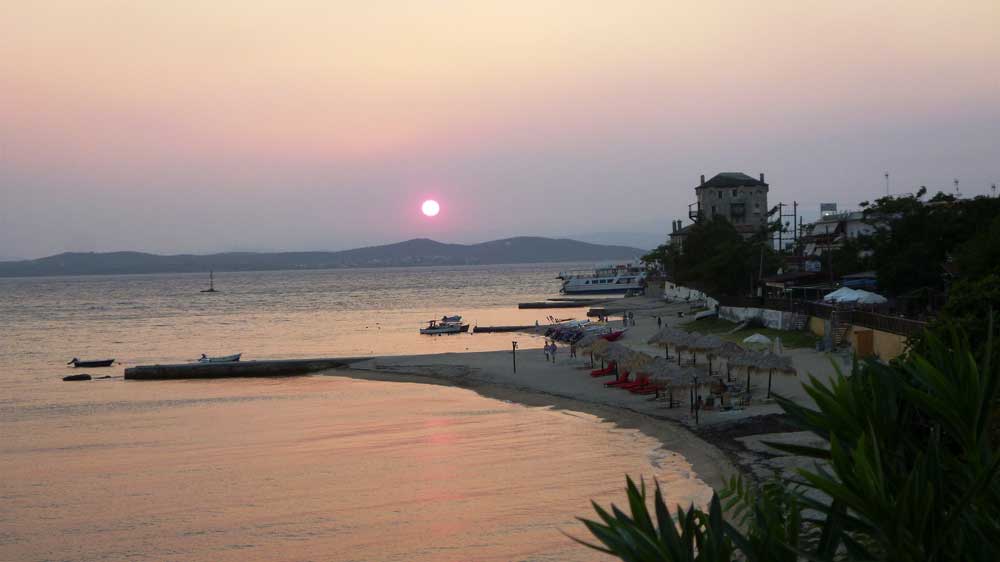
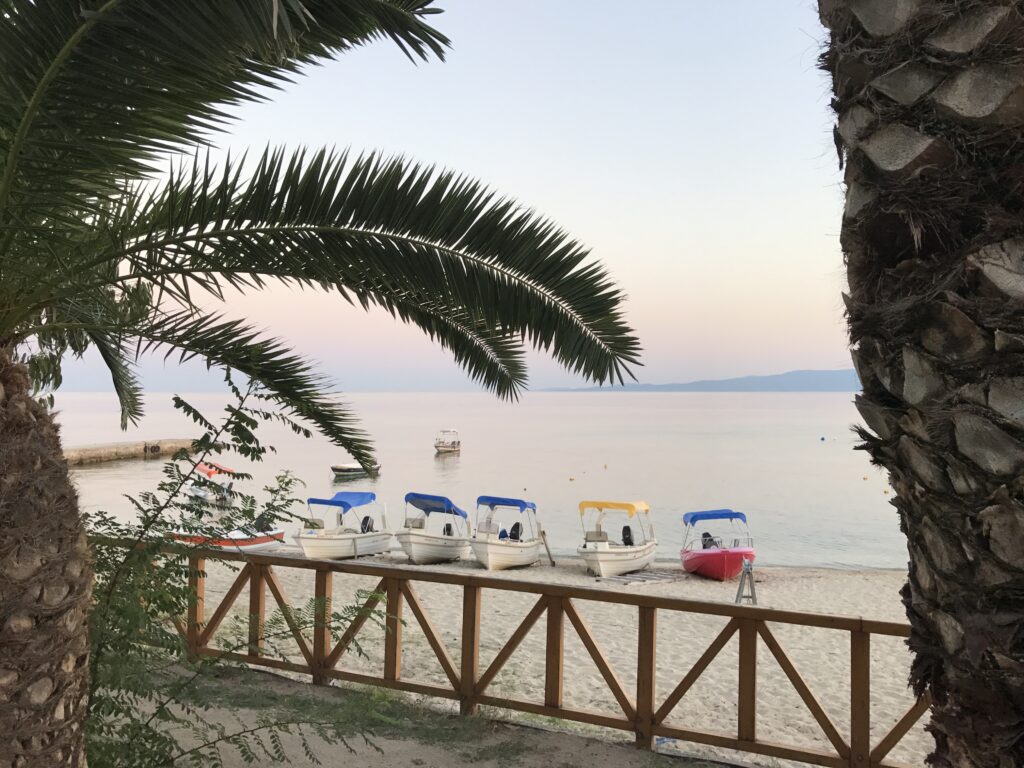
The promenade on the west side of the village by the port, with it’s restaurants and cafes, is a wonderful place to leisurely spend the whole day, under the shaded foliage, by the sea, and watch the world go by. The little port is busy. Very early in the morning monks in black habits and pilgrims hurry to catch the boat for Mount Athos. Small wooden fishing boats arrive with the day’s catch. Later come the tourists, boarding large boats for the daily tour, eager to see the towering monasteries of the Holy Mountain from a distance. Finally smaller open boats with white canopies, start their regular trips to the islands opposite.
Throughout the day private and hire boats leave for every direction, looking to discover a new beach, a deserted cove, to enjoy the warm sun and the clear blue sea. They will be seen again in late afternoon, appearing through a sea of yellow and crimson, while the perfect red disk of the sun lowers itself far in the distance, reflecting a flaming stream on the calm sea. Everybody makes for the restaurants by the sea, to while the evening with friends, recounting the day’s exploits. At night, the lights of the restaurants along the promenade mirror on the limpid sea, forming mysterious flashing patterns. Far in the distance the lights of Ammouliani, the monotonous flashing of the lighthouse, the flickering lamps of the fishing boats, a wonderful, magical world out there.
Across the water, a very short boat ride from Ouranoupolis there is a group of small deserted islands, some of them no more than rocks rising from the sea, home only to nesting sea-birds. Only Ammouliani (fine sand), the larger one is inhabited, a traditional fishing village with wonderful sandy beaches.
This is a paradise of golden sand and clear blue sea. The unbelievably sparkling, limpid sea is crowded with fishes in all their varieties. Tiny whitebait panic before hungry larger fish and flicker in and out of the sea in their fright, to be caught into the jaws of diving birds or seagulls on breaking surface. Dolphins wheel playfully. In the dying sunlight monster swordfish heave themselves into the air, the pink glint of evening on their silvery skin.
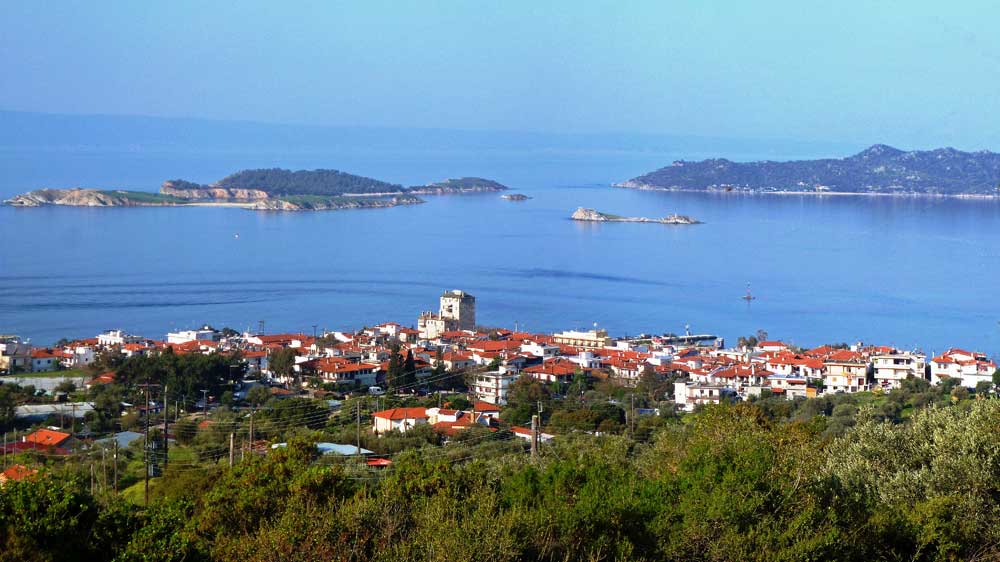
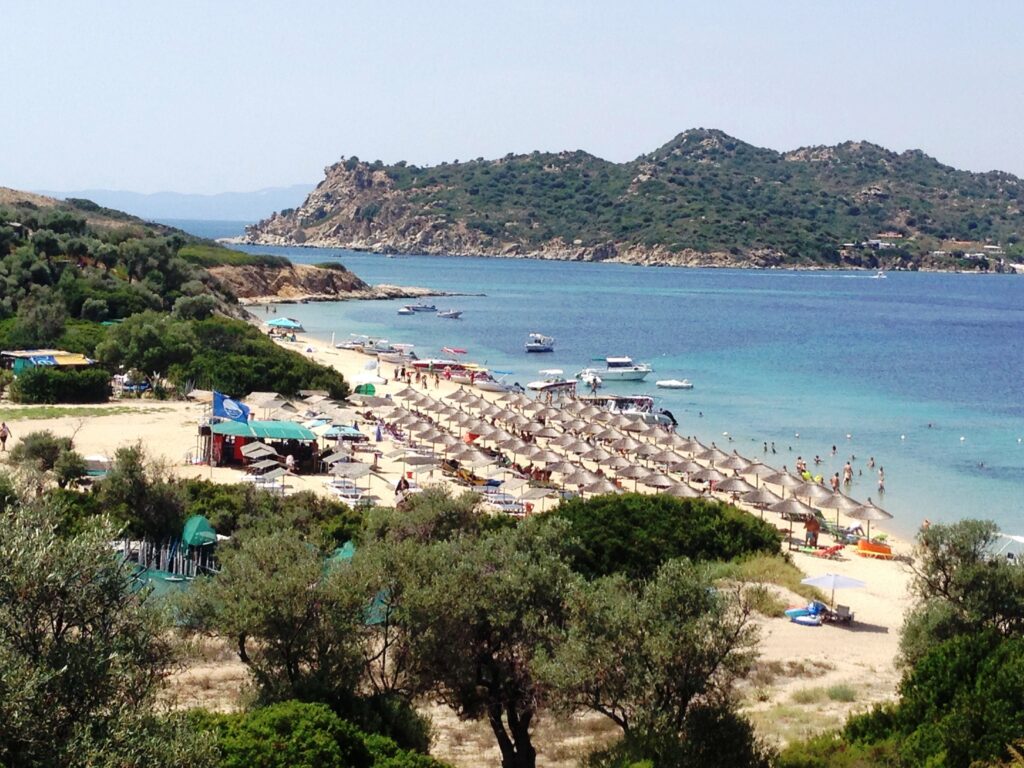
The larger of these islands, the “donkey” island, named after it’s inhabitants for the rest of the year, is a full mile round. During the summer there is a regular boat service from the jetty by the tower to this lovely island. The sand is fine gold and the sea is always peaceful and warm. A few olive trees provide shelter from the strong midday sun, and a taverna, the only structure on the whole island, provides sustenance, fresh fish and draught larger or the local tsipouro. And if you are lucky to catch any fish they might even cook it for you. Then you can eat your catch by the whispering sea and imagine that tomorrow you may catch something bigger.
Many people prefer to do their own thing, to spend the day in peace and quite away from the rest. A hired boat is a great idea for you will be free to explore the islands and discover a new beach. You are bound to find a deserted cove where you could spend the whole day undisturbed, a modern day Robinson Crusoe.
